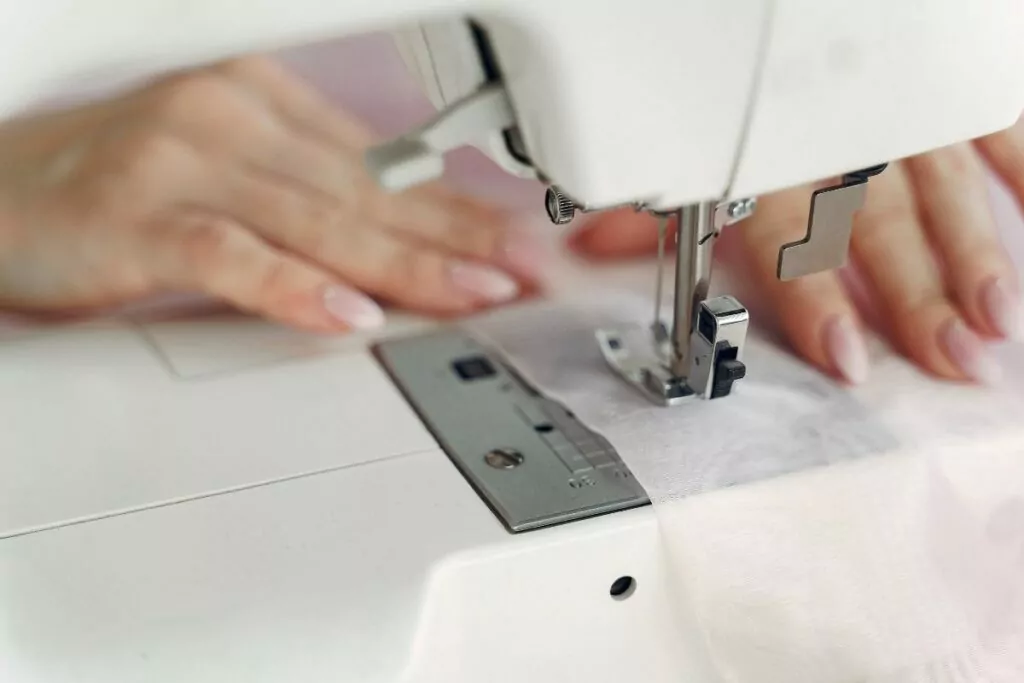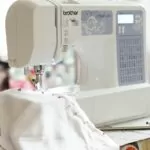Sewing is a great way to create unique, one-of-a-kind items that will last for many years.
It can also be an enjoyable hobby or a useful skill in your repertoire – and knowing how to join two pieces of fabric together is a crucial part of the process.

In this article, we’ll explain the basics of sewing different fabrics together, from choosing the right thread and needles to trying out different stitching techniques.
So grab your sewing supplies and let’s get started!
Which Materials Do I Need?
To get started with sewing fabrics together, there are a few things you will need, and these include:
- Fabric pieces to be sewn
- Matching thread
- Sewing machine or needle and thread
- Pins or clips
- Scissors
- Measuring tape or ruler
How To Sew Fabrics Together

Once you have gathered your materials, the next step is to sew your chosen fabric pieces together – and we have a step-by-step guide below.
Prepare Your Fabric
Before you begin sewing, it’s important to prepare your fabric pieces properly. Start by washing and ironing them to eliminate any creases or shrinkage.
Then, lay the fabric pieces flat on a clean, flat surface, ensuring they are properly aligned.
It is also important to ensure that the fabric pieces are cut to the right size, as this will affect how they fit together.
If you need to, use a ruler or measuring tape to measure the length and width of each piece.
Choosing The Right Needle And Thread
Selecting the appropriate thread and needle for your project is crucial, and this is the next step on your list.
For most general sewing projects, polyester or polyester-blend threads work well, as these are strong and long-lasting.
When it comes to needles, you may want to choose one that matches the weight of your fabric – for example, a thick needle for heavy fabrics and a thin needle for light fabrics.
It is also important to make sure your needle isn’t too long or too short for your fabric.
Thread Your Machine Or Needle

The next step is to thread your sewing machine or needle – if you are using a machine, make sure it is properly threaded before you begin.
If you are using a needle and thread, the process is simple: just tie the end of the thread to the eye of your needle and pull it through until there is enough thread for your project.
Choose a thread color that matches your fabric, or a contrasting color if you prefer a decorative touch.
When it comes to needles, opt for a universal needle (size 80/12) for medium-weight fabrics. Remember to replace your needle regularly to ensure smooth stitching.
Pin Or Clip Your Fabrics
To keep your fabric pieces in place during sewing, use pins or clips.
Pinning is ideal for woven fabrics, while clips work well for knits or delicate fabrics, as they apply less pressure, and so keep the fabric intact.
Place the pins or clips perpendicular to the sewing line, about an inch apart, and make sure the layers of fabric are aligned perfectly.
Select The Right Stitch
The type of stitch you choose depends on the purpose of your project. The straight stitch is the most common and versatile option, perfect for securing seams and hems.
For stretchy fabrics or decorative purposes, consider using a zigzag stitch. It is a good idea to experiment with different stitch lengths and widths to achieve the desired effect.
Sew The Fabrics Together
If you’re using a sewing machine, adjust the stitch length according to your project.
Begin sewing by guiding the fabric layers carefully through the machine, keeping them aligned with the seam allowance.
Backstitch at the beginning and end of the seam to reinforce it.
If you prefer hand sewing, use a basic running stitch or back stitch, ensuring your stitches are even and secure.
Finish The Seam
Once you’ve sewn the fabrics together, it’s important to finish the seam to prevent fraying.
You can achieve this by using an overlock stitch on your sewing machine, by investing in a serger, or by trimming the seam allowance and using a zigzag stitch along the raw edge.
Alternatively, you can sew a separate line of stitching called a French seam for a neat and enclosed finish.
Pressing And Final Touches
To give your sewn fabrics a professional look, don’t forget to press the seam.
Set your iron to the appropriate temperature for your fabric type, and press the seam flat or open, depending on the project. Be cautious not to stretch or distort the fabric while pressing.
Finally, trim any loose threads and admire your beautifully sewn fabrics!
Top Tips For Joining Fabrics
In addition to our step-by-step guide above, here are some top tips for joining fabrics successfully:
- Use a sharp needle and thread that match the weight of your fabric.
- Always test any new stitch or technique on scrap fabric first.
- Take your time when aligning the layers of fabric – this will make sewing them together much easier.
- Finish seams to prevent fraying and give a professional look to your project.
- Finally, practice makes perfect – the more you stitch, the better you’ll become!
Final Thoughts
With a bit of practice and the right materials, you can learn how to sew fabrics together quickly and easily.
Follow our detailed guide above, along with our top tips, and you’ll be joining fabrics in no time, allowing you to begin creating beautiful garments and home décor which will make you proud.
- How To Sew Fabrics Together - June 5, 2023
- How Many Stitches Per Inch? - June 5, 2023
- How Long Does It Take To Sew A Dress? - June 5, 2023










